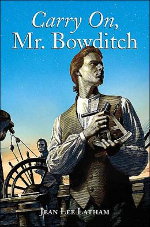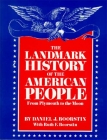 There is an absolutely execellent blog post over at the Sonlight blog on the importance of teaching children to fail. This is something about which we frequently speak in the Chapman household. Sarita Holzman reminded of us of one our absolute most favorite Sonlight books, Carry On, Mr. Bowditch. It is a book about the life of a man who lived in Colonial America who, when he was young, did not have a lot of advantages in terms of education, but availed himself of everything within his means and perserved in educating himself to the benefit of the shipping world, even today. We also liked it a lot that he was a multilingal math guy. Part of failing successfully is not looking back, but learning from the failure going on in the best way possible under the circumstances.
There is an absolutely execellent blog post over at the Sonlight blog on the importance of teaching children to fail. This is something about which we frequently speak in the Chapman household. Sarita Holzman reminded of us of one our absolute most favorite Sonlight books, Carry On, Mr. Bowditch. It is a book about the life of a man who lived in Colonial America who, when he was young, did not have a lot of advantages in terms of education, but availed himself of everything within his means and perserved in educating himself to the benefit of the shipping world, even today. We also liked it a lot that he was a multilingal math guy. Part of failing successfully is not looking back, but learning from the failure going on in the best way possible under the circumstances.
Day: May 2, 2013
 My cousin, Trisha, teaches at a school with somewhere in the range of 30-40 students in the (very) small town of Austin, Nevada. She writes an absolutely fascinating blog called RollCallTales about a school that is so small, the principal works at another school over two hours away and all the teachers teach multiple grades. I think Trisha’s oldest students are in third grade. Austin is a ranch community so her students live a long way from town, only go to school four long days per week because many of them travel a long way to get there. These are kids who know a lot about rural life in a cowboy culture. Trisha has unique challenges and chronicles them in an engaging manner. It is one of my first stops in the blogosphere every day.
My cousin, Trisha, teaches at a school with somewhere in the range of 30-40 students in the (very) small town of Austin, Nevada. She writes an absolutely fascinating blog called RollCallTales about a school that is so small, the principal works at another school over two hours away and all the teachers teach multiple grades. I think Trisha’s oldest students are in third grade. Austin is a ranch community so her students live a long way from town, only go to school four long days per week because many of them travel a long way to get there. These are kids who know a lot about rural life in a cowboy culture. Trisha has unique challenges and chronicles them in an engaging manner. It is one of my first stops in the blogosphere every day.
Trisha is a teacher because she loves to teach. She is not one of those teachers who believes all teachers are underpaid although she, like the rest of us, would like to earn more money. She is one of those teachers who is not in it for the money. She recently turned down an offer for a job with significantly better pay in a town where she could actually buy groceries without making a three hour drive. She did not turn it down because she loves being so isolated although I do not think that bothers her so much. Nor did she turn it down because of the stellar staff at the school or in the district (they might actually be stellar, but that is not the point). She turned it down because of the kids. This post on her blog about the state tests her kids must take exemplifies her passion for her work.
Trisha loves to write, has an eye for all things quirky, and loves to record interesting anecdotes, events, and images that describe the human condition. She has a hilarious story of riding in the car with two little girls in the second or third grade from her class on the way to a field trip to a museum. One of the little barrel-rider cowgirls used her horsey plush toy as a prop to explain to the other little girl how to preg-test a mare. The picture that accompanies this post is one she put up of a message the janitor left in her classroom one evening when the whiteboard had no writing on it. Her writing is interesting day in and day out.
Trisha currently lives above the town saloon that is only open for a few weeks per year when people flood into the town for an annual festival. She lives in an amazingly picturesque place that most of us would love to visit but that requires people with robust spirits to inhabit all year long.
Day 619 of 1000
This is the fourth in a series of articles about why we used Sonlight Curricula in our homeschool. Here is a page that holds an introduction to the series and links to the other posts in the series. We bought core packages for what would be third through tenth grades in a traditional school. Kelly used the program from fifth through tenth grade. Christian used the program from third through eighth grade. This series mostly describes what we did for all the subject areas except math, music, and art. I have already written pretty extensively on this blog about what we did for math and plan to do a future series on our art art program. We bought most, but not all of our core materials from Sonlight and followed their curriculum guides with a fair amount of rigor. Like most other homeschoolers, we deviated in minor ways where we saw fit.
[Previous post]
[Next post]
I have written what I have to write about the Sonlight history program in other places so this will be a brief overview of how it served us and a link or two to the posts that go into more detail. In a nutshell, there were some things we absolutely loved about how Sonlight handles history, but there was one part of the program-the Joy Hakim series for US History–we found totally unsuitable for our needs both in terms of the quality and depth of the history coverage. We made the mistake of buying the stuff that did not work for us before we sufficiently checked it out because our previous experience with the Sonlight History curricula had been so stellar.
 In a nutshell, the things we really liked about the History program is that the Literature and History books and study guides are so will coordinated with each other. As mentioned above, we started back into homeschool when one of our children entered third grade and the other entered fifth grade. The curriculum we picked for the third grader featured The Land Mark History of the American People Volume I. I started reading it aloud to Christian, our third grader, but after the first chapter, it was so excellent, we started over so we could include our fifth grader in the reading even though she was working her way through the equivalent of what I think is now called the Eastern Hemisphere.
In a nutshell, the things we really liked about the History program is that the Literature and History books and study guides are so will coordinated with each other. As mentioned above, we started back into homeschool when one of our children entered third grade and the other entered fifth grade. The curriculum we picked for the third grader featured The Land Mark History of the American People Volume I. I started reading it aloud to Christian, our third grader, but after the first chapter, it was so excellent, we started over so we could include our fifth grader in the reading even though she was working her way through the equivalent of what I think is now called the Eastern Hemisphere.
So in the final analysis, we highly recommend the first two-year pass through US History called Introduction to American History I and II. We loved the wonderful one year pass through the Eastern Hemisphere and the two year survey of World History I and II. We strongly recommend skipping the one year American History in Depth. We used the provided Literature books, but found something to replace the Joy Hakim books with what we believe was a much better written, more in-depth, interesting, and honest account of American History. The adjustments were required to allow us to better prepare our children to study History in college. We write more about our thinking on this material here, here, here and here.
